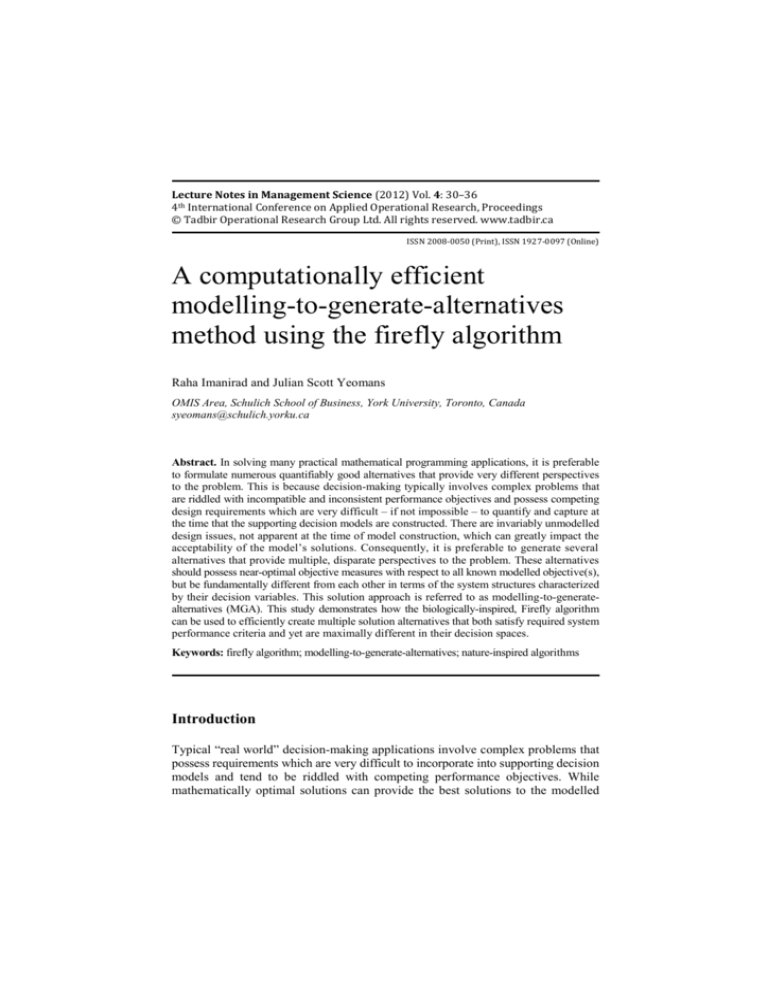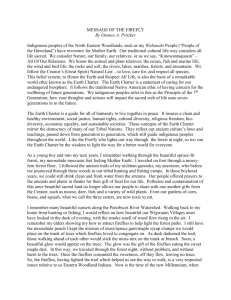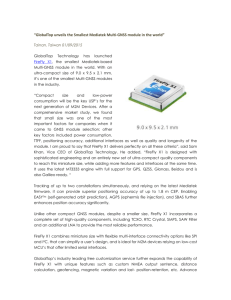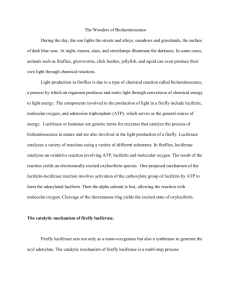
Lecture Notes in Management Science (2012) Vol. 4: 30–36
4th International Conference on Applied Operational Research, Proceedings
© Tadbir Operational Research Group Ltd. All rights reserved. www.tadbir.ca
ISSN 2008-0050 (Print), ISSN 1927-0097 (Online)
A computationally efficient
modelling-to-generate-alternatives
method using the firefly algorithm
Raha Imanirad and Julian Scott Yeomans
OMIS Area, Schulich School of Business, York University, Toronto, Canada
syeomans@schulich.yorku.ca
Abstract. In solving many practical mathematical programming applications, it is preferable
to formulate numerous quantifiably good alternatives that provide very different perspectives
to the problem. This is because decision-making typically involves complex problems that
are riddled with incompatible and inconsistent performance objectives and possess competing
design requirements which are very difficult – if not impossible – to quantify and capture at
the time that the supporting decision models are constructed. There are invariably unmodelled
design issues, not apparent at the time of model construction, which can greatly impact the
acceptability of the model’s solutions. Consequently, it is preferable to generate several
alternatives that provide multiple, disparate perspectives to the problem. These alternatives
should possess near-optimal objective measures with respect to all known modelled objective(s),
but be fundamentally different from each other in terms of the system structures characterized
by their decision variables. This solution approach is referred to as modelling-to-generatealternatives (MGA). This study demonstrates how the biologically-inspired, Firefly algorithm
can be used to efficiently create multiple solution alternatives that both satisfy required system
performance criteria and yet are maximally different in their decision spaces.
Keywords: firefly algorithm; modelling-to-generate-alternatives; nature-inspired algorithms
Introduction
Typical “real world” decision-making applications involve complex problems that
possess requirements which are very difficult to incorporate into supporting decision
models and tend to be riddled with competing performance objectives. While
mathematically optimal solutions can provide the best solutions to the modelled
R Imanirad and JS Yeomans
31
problems, they are generally not the best answers to the underlying real problems
as there are invariably unquantified issues and unmodelled objectives not apparent
at the time of model construction. Consequently, it is preferable to generate a
number of different alternatives that provide multiple, disparate perspectives to the
particular problem (Yeomans & Gunalay 2011). Preferably these alternatives
should all possess good (i.e. near-optimal) objective measures with respect to the
modelled objective(s), but be as fundamentally different as possible from each
other in terms of the system structures characterized by their decision variables. In
response to this option creation requirement, several approaches collectively referred
to as modelling-to-generate-alternatives (MGA) have been developed (Loughlin
et al. 2001). The primary motivation behind MGA is to produce a manageably
small set of alternatives that are good with respect to modelled objectives yet as
different as possible from each other in the decision space. In so doing, the resulting
alternative solution set is likely to provide truly different choices that all perform
somewhat similarly with respect to the modelled objectives, yet very differently
with respect to the unmodelled issues.
In this paper, it is shown how to efficiently generate a set of maximally different
solution alternatives by implementing a modified version of the Firefly Algorithm
(FA) of Yang (2010). For optimization purposes, Yang (2010) has demonstrated
that FA is more computationally efficient than such commonly-used metaheuristics as
genetic algorithms, simulated annealing, and enhanced particle swarm optimization.
Hence, this new innovative MGA approach using FA is a very computationally
efficient procedure. This study illustrates the efficacy of the MGA capabilities of
this new FA approach procedure in constructing multiple, good-but-very-different
solution alternatives to a constrained optimization test problem.
Firefly algorithm for function optimization
While this section provides a brief synopsis of the steps involved in the FA process,
more specific details can be found in Yang (2010). The FA is a biologically-inspired
metaheuristic that employs the following three idealized rules: (i) All fireflies are
unisex so that one firefly will be attracted to other fireflies irrespective of their
sex; (ii) Attractiveness between fireflies is proportional to their brightness, implying
that for any two flashing fireflies, the less bright one will move towards the
brighter one. Attractiveness and brightness both decrease as the distance between
fireflies increases. If there is no brighter firefly within its visible vicinity, then a
particular firefly will move randomly; and (iii) The brightness of a firefly is
determined by the landscape of the objective function. Namely, for a maximization
problem, the brightness can simply be proportional to the value of the objective
function. Based upon these three rules, the basic steps of the FA are summarized
within the pseudo-code of Figure 1.
32
Lecture Notes in Management Science Vol. 4: ICAOR 2012, Proceedings
Objective Function f(X), X = (x1, x2,…xd)
Generate the initial population of n fireflies, Xi, i = 1,
2,…,n
Light intensity Ii at Xi is determined by f(Xi)
Define the light absorption coefficient γ
while (t < MaxGeneration)
for i = 1: n , all n fireflies
for j = 1: n ,all n fireflies (inner loop)
if (Ii < Ij), Move firefly i towards j; end if
Vary attractiveness with distance r via e- γr
end for j
end for i
Rank the fireflies and find the current global
best solution g*
end while
Postprocess the results
Fig. 1. Pseudo Code of the Firefly Algorithm
In the FA, there are two important issues to resolve: the variation of light intensity
and the formulation of attractiveness. For simplicity, it can always be assumed that
the attractiveness of a firefly is determined by its brightness which in turn is associated
with the encoded objective function. In the simplest case, the brightness of a firefly
at a particular location X would be its calculated objective value F(X). However,
the attractiveness, , between fireflies is relative and will vary with the distance rij
between firefly i and firefly j. In addition, light intensity decreases with the distance
from its source, and light is also absorbed in the media, so the attractiveness
should be allowed to vary with the degree of absorption. Consequently, the overall
attractiveness of a firefly can be defined as = 0 exp(- r 2 ), where 0 is the
attractiveness at distance r = 0 and is the fixed light absorption coefficient for a
specific medium. If the distance rij between any two fireflies i and j located at Xi
and Xj, respectively, is calculated using the Euclidean norm, then the movement of
a firefly i that is attracted to another more attractive (i.e. brighter) firefly j is
determined by X i = Xi + 0 exp(- rij) 2)(Xi – Xj) + i .
In this expression of movement, the second term is due to the relative attraction
and the third term is a randomization component. Yang (2010) indicates that is a
randomization parameter normally selected within the range [0,1] and i is a vector
of random numbers drawn from either a Gaussian or uniform (generally [-0.5,0.5])
distribution. It should be pointed out that this expression is a random walk biased
toward brighter fireflies and if 0 = 0, it becomes a simple random walk. The parameter
characterizes the variation of the attractiveness and its value determines the
speed of the algorithm’s convergence. For most applications, is typically set between
0.1 to 10 (Yang 2010). In any given optimization problem, for a very large number
of fireflies n >> k where k is the number of local optima, the initial locations of the
R Imanirad and JS Yeomans
33
n fireflies should be distributed relatively uniformly throughout the entire search
space. As the FA proceeds, the fireflies would converge into all of these local optima
(including the global ones). By comparing the best solutions among all these optima,
the global optima can easily be determined. Yang (2010) demonstrates that the FA
will approach the global optima when n and the number of iterations t, is set
so that t >>1. In reality, the FA has been found to converge extremely quickly.
Two important limiting or asymptotic cases occur when 0 and when
. For 0, the attractiveness is constant = 0, which is equivalent to having
a light intensity that does not decrease. Thus, a firefly would be visible anywhere
within the solution domain. Hence, a single (usually global) optima can easily be
reached. If the inner loop for j in Figure 1 is removed and Xj is replaced by the
current global best g*, then this implies that the FA becomes a special case of the
accelerated particle swarm optimization (PSO) algorithm. Subsequently, the computational efficiency of this special case of the FA is equivalent to that of enhanced
PSO. Conversely, when , the attractiveness is essentially zero in the sightline
of other fireflies. This is equivalent to the case where the fireflies randomly roam
throughout a very thick foggy region. No other fireflies are visible and each firefly
roams in a completely random fashion. This case corresponds to a completely random
search method. As the FA operates between these two extremes, it is possible to
adjust the parameters and so that the FA can outperform both the random
search and the enhanced PSO algorithms. Furthermore, the FA can find both the
global optima as well as the local optima concurrently which holds huge computational
and efficiency advantages for MGA purposes (Yeomans and Gunalay 2011). Another
additional advantage of the FA for MGA implementation is that different fireflies
essentially work independently of each other and FA are thus better than genetic
algorithms and PSO for MGA because the fireflies can aggregate more closely
around each local optimum.
Modelling to generate alternatives with the firefly algorithm
In most “real world” decision problems, there are numerous system objectives and
requirements that are never made explicitly apparent or included at the decision
formulation stage. Furthermore, it may never be possible to explicitly express all
of the subjective considerations because there are frequently numerous incompatible,
competing, adversarial stakeholder groups. Therefore most subjective aspects remain
unquantified and unmodelled in the construction of any corresponding decision
models. This is a common occurrence in situations where the final decisions are
constructed based not only upon clearly stated and modelled objectives, but also
upon fundamentally subjective, political and socio-economic goals and stakeholder
preferences (Yeomans and Gunalay 2011). When unmodelled objectives and
unquantified issues exist, different approaches are required in order to not only
search the decision space for the noninferior set of solutions, but also to explore
the decision space for inferior alternative solutions to the modelled problem.
34
Lecture Notes in Management Science Vol. 4: ICAOR 2012, Proceedings
In order to properly motivate an MGA search procedure, it is necessary to provide a
more formal definition of the goals of the MGA process (Loughlin et al. 2001;
Yeomans and Gunalay 2011). Suppose the optimal solution to an original mathematical
model is X* with objective value Z* = F(X*). The following model can then be
solved to generate an alternative solution that is maximally different from X*:
Max =
Subject to:
i
| Xi - Xi* |
XD
| F(X) - Z* |
T
where is a difference function and T is a target specified in relation to the original
optimal function value Z*. T is a user-supplied value that represents how much of
the inferior region is to be explored for alternative solutions. The FA-based MGA
procedure is designed to generate a small number of good but maximally different
alternatives by adjusting the value of T and using the FA to solve the corresponding,
new maximal difference problem instance. In this approach, subpopulations within
the algorithm’s overall population are established as the Fireflies collectively
evolve toward different local optima in the solution space. Each desired solution
alternative undergoes the common search procedure of the FA. The survival of
solutions depends upon how well the solutions perform with respect to the modelled
objective(s) and by how far away they are from all of the other previously generated
alternatives in the decision space.
Computational testing of the firefly algorithm used for MGA
The application of the MGA procedure will be illustrated using a spring design
problem taken from Cagnina et al. (2008). The design of a tension and compression
spring has frequently been employed as a benchmark problem for constrained
engineering optimization problems (Cagnina et al. 2008). The problem involves
three design variables: (i) x1 , the wire diameter, (ii) x 2 , the coil diameter, and
(iii) x 3 , the length of the coil. The aim is to essentially minimize the weight subject
to constraints on deflection, stress, surge frequency and geometry. The mathematical
formulation for this test problem can be summarized as:
Min F(X) = x1 x2 2 x3
Subject to:
2
g1(X) = 1 –
x 23 x3
71785x14
0
R Imanirad and JS Yeomans
g2(X) =
4 x 22 x1 x 2
12566 x13 x 2
g3(X) = 1 –
140.45x1
x 22 x3
x14
+
35
1
–1 0
5108x12
0
x1 x 2
–1 0
1.5
0.05 x1 2.0
0.25 x 2 1.3
2.0 x 3 15.0
g4(X) =
For the design parameters employed in this specific problem formulation,
Cagnina et al. (2008) provide a best solution of F(X*) = 0.0127 with X* =
(0.051690, 0.356750, 11.287126). However, as outlined earlier, planners generally
prefer to be able to select from a set of “near-optimal” alternatives that significantly
differ from each other in terms of the system structures characterized by their
decision variables. In order to create this set of alternative planning options, extra
target constraints that varied the value of T were placed into this original formulation
in order to force the generation of solutions that were maximally different from
the initial optimal solution. The MGA difference model described in the previous
section was used to produce the optimal solution and the 10 maximally different
solutions shown in Table 1.
As described earlier, many problems are typically riddled with incongruent
performance requirements that contain significant stochastic uncertainty that are
also very difficult to quantify. Consequently, it is preferable to create several
quantifiably good alternatives that concurrently provide very different perspectives
to the potentially unmodelled performance design issues during the policy formulation
stage. The unique performance features captured within these dissimilar alternatives
can result in very different system performance with respect to the unmodelled issues,
thereby incorporating the unmodelled issues into the actual solution process. This
example has demonstrated how an MGA modelling perspective can be used to
generate multiple, good policy alternatives via the computationally efficiently FA
that satisfy required system performance criteria according to prespecified bounds
and yet remain as maximally different from each other as possible in the decision
space. In addition to its alternative generating capabilities, the MGA procedure
has simultaneously performed exceedingly well with respect to its role in function
optimization. It should be explicitly noted that the cost of the overall best solution
produced by the MGA procedure is indistinguishable from the one determined in the
much more straightforward function optimization approach of Cagnina et al. (2008).
36
Lecture Notes in Management Science Vol. 4: ICAOR 2012, Proceedings
Table 1. Objective Values and Solutions for the 11 Maximally Different Alternatives.
Increment
1% Increment Between Alternatives
F(X)
Optimal
Alternative 1
Alternative 2
Alternative 3
Alternative 4
Alternative 5
Alternative 6
Alternative 7
Alternative 8
Alternative 9
Alternative 10
0.0127
0.0128
0.0128
0.0129
0.013
0.0131
0.0134
0.0135
0.0137
0.0138
0.0140
x1
0.05
0.05
0.0514
0.0529
0.0521
0.0527
0.05
0.0524
0.052
0.0523
0.0535
x2
0.3174
0.3164
0.3472
0.3862
0.3656
0.3766
0.3157
0.3597
0.3629
0.348
0.3857
x3
14.0324
14.1754
12.0089
9.9684
11.0667
10.5179
14.978
11.6966
12.1615
13.3247
14.162
2.5% Increment Between Alternatives
F(X)
0.0127
0.0128
0.0131
0.0132
0.0140
0.0143
0.0146
0.0149
0.0152
0.0156
0.0159
x1
0.05
0.05
0.05
0.05
0.0557
0.0542
0.0546
0.0562
0.0605
0.0574
0.0553
x2
0.3174
0.3165
0.3129
0.3167
0.4307
0.4014
0.4247
0.438
0.4836
0.3841
0.4072
x3
14.0322
14.1598
14.777
14.6402
9.5783
11.6481
10.7556
11.1197
8.9963
14.5182
15.0000
Conclusions
In this paper, a procedure was presented that demonstrated how the computationally
efficient FA could be used to generate multiple, maximally different, near-best
alternatives. In this MGA capacity, the FA produces numerous solutions possessing
the requisite problem characteristics, with each generated alternative providing a
very different perspective. Since FA techniques can be adapted to solve a wide
variety of problem types, the practicality of this MGA approach can clearly be
extended into numerous disparate planning applications. These extensions will be
studied in future research.
References
Cagnina LC, Esquivel CA, and Coello CA (2008). Solving Engineering Optimization Problems
with the Simple Constrained Particel Swarm Optimizer. Informatica 32: 319-326.
Loughlin DH, Ranjithan S.R, Brill ED and Baugh JW (2001). Genetic Algorithm Approaches
for Addressing Unmodeled Objectives in Optimization Problems. Engineering Optimization
33(5): 549-569.
Yang XS (2010). Nature-Inspired Metaheuristic Algorithms 2nd Ed. Luniver Press. Frome, UK.
Yeomans JS and Gunalay Y (2011). Simulation-Optimization Techniques for Modelling to
Generate Alternatives in Waste Management Planning. Journal of Applied Operational
Research 3(1): 23-35.







